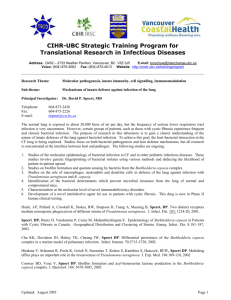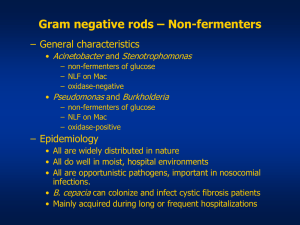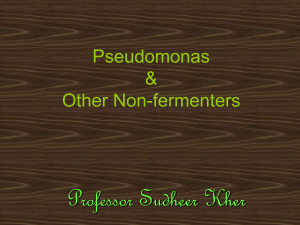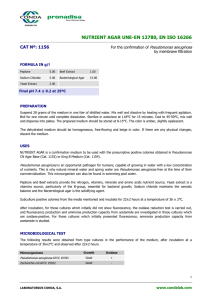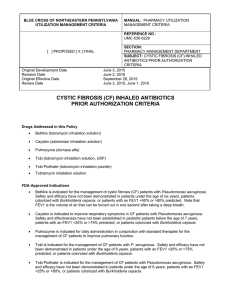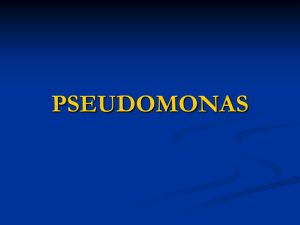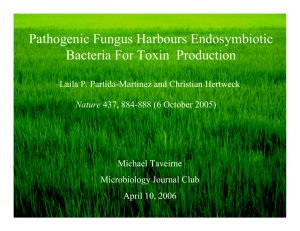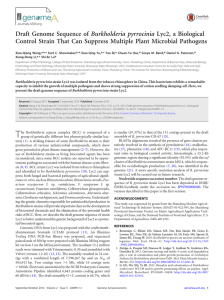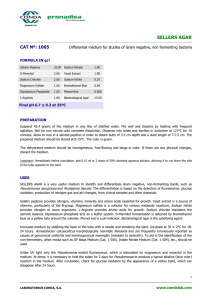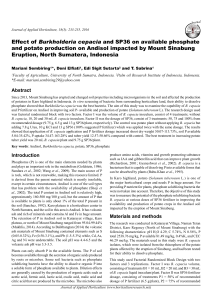BURKHOLDERIA CEPACIA AGAR BASE CAT Nº: 1347 Burkholderia cepacia
advertisement
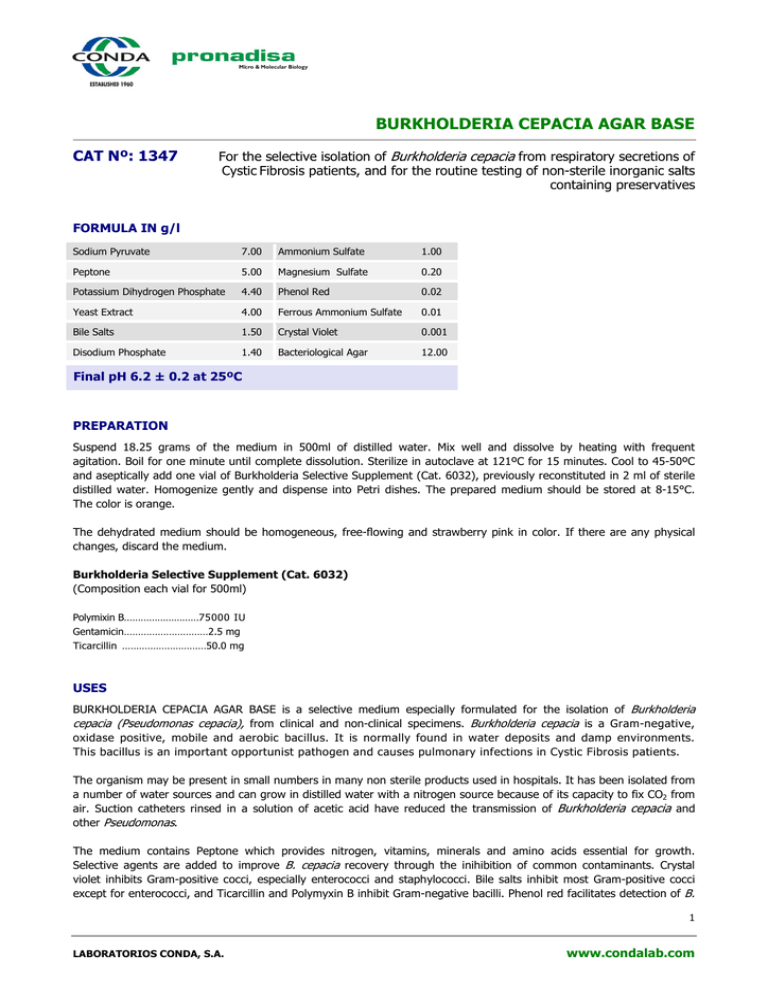
BURKHOLDERIA CEPACIA AGAR BASE CAT Nº: 1347 For the selective isolation of Burkholderia cepacia from respiratory secretions of Cystic Fibrosis patients, and for the routine testing of non-sterile inorganic salts containing preservatives FORMULA IN g/l Sodium Pyruvate 7.00 Ammonium Sulfate 1.00 Peptone 5.00 Magnesium Sulfate 0.20 Potassium Dihydrogen Phosphate 4.40 Phenol Red 0.02 Yeast Extract 4.00 Ferrous Ammonium Sulfate 0.01 Bile Salts 1.50 Crystal Violet 0.001 Disodium Phosphate 1.40 Bacteriological Agar 12.00 Final pH 6.2 ± 0.2 at 25ºC PREPARATION Suspend 18.25 grams of the medium in 500ml of distilled water. Mix well and dissolve by heating with frequent agitation. Boil for one minute until complete dissolution. Sterilize in autoclave at 121ºC for 15 minutes. Cool to 45-50ºC and aseptically add one vial of Burkholderia Selective Supplement (Cat. 6032), previously reconstituted in 2 ml of sterile distilled water. Homogenize gently and dispense into Petri dishes. The prepared medium should be stored at 8-15°C. The color is orange. The dehydrated medium should be homogeneous, free-flowing and strawberry pink in color. If there are any physical changes, discard the medium. Burkholderia Selective Supplement (Cat. 6032) (Composition each vial for 500ml) Polymixin B………………………75000 IU Gentamicin…………………………2.5 mg Ticarcillin …………………………50.0 mg USES BURKHOLDERIA CEPACIA AGAR BASE is a selective medium especially formulated for the isolation of Burkholderia cepacia (Pseudomonas cepacia), from clinical and non-clinical specimens. Burkholderia cepacia is a Gram-negative, oxidase positive, mobile and aerobic bacillus. It is normally found in water deposits and damp environments. This bacillus is an important opportunist pathogen and causes pulmonary infections in Cystic Fibrosis patients. The organism may be present in small numbers in many non sterile products used in hospitals. It has been isolated from a number of water sources and can grow in distilled water with a nitrogen source because of its capacity to fix CO2 from air. Suction catheters rinsed in a solution of acetic acid have reduced the transmission of Burkholderia cepacia and other Pseudomonas. The medium contains Peptone which provides nitrogen, vitamins, minerals and amino acids essential for growth. Selective agents are added to improve B. cepacia recovery through the inihibition of common contaminants. Crystal violet inhibits Gram-positive cocci, especially enterococci and staphylococci. Bile salts inhibit most Gram-positive cocci except for enterococci, and Ticarcillin and Polymyxin B inhibit Gram-negative bacilli. Phenol red facilitates detection of B. 1 LABORATORIOS CONDA, S.A. www.condalab.com cepacia. Alkaline end products from the metabolism of pyruvate raise the pH of the medium, causing the color of the indicator to change from light orange to pink, or pink-red, in the growth area. In areas of heavy B. cepacia growth, the pink color intensifies. Magnesium sulphate, Ammonium sulphate and Ferrous sulfate provide sources of sulfates and metallic ions. Phosphate salts act as a buffer system. Bacteriological agar is the solidifying agent. Inoculate and incubate at 37°C for 48 to 72 hours. Colonies of B. cepacia are 1-2mm in diameter and turn the medium to pink. Low numbers of colonies may not produce a color change of the medium. Occasional growth of some strains of Candida species, Stenotrophomonas maltophilia, Pseudomonas aeruginosa and other Pseudomonas species may occur. MICROBIOLOGICAL TEST The following results were obtained in the performance of the medium from type cultures after incubation at a temperature of 37ºC and observed after 48-72 hours. Microorganisms Burkholderia cepacia ATCC 25608 Pseudomonas aeruginosa ATCC 27853 Growth Good Inhibited BIBLIOGRAPHY Bahame, J. B. and Schroth, M. N. [1989): Spatial-temporal colonization pattems of a rhizobacterium on underground organs of potato Phytopatology. Vol.77:1 093-1100. Barelmann, I.; Meyer, I.M.; Taraz, K. and Budzikiewicz, D. [1996): Cepaciachelin, a new catecholate siderophore from Burkholderia [Pseudomonas) cepacia. Z Natarfosch. Vol. 51: 627-630. Bashan, Y. and Holguin, Gina. [1998): Proposal for the Division of plant growth–promoting rhizobacteria into two classifications: biocontrolPGPB [plant growth–promoting bacteria) and PGPB. Soil Biol Biochem. Vol. 30[8-9): 1225-1228. STORAGE 25ºC Once opened keep powdered medium closed to avoid hydration. 2ºC 2 LABORATORIOS CONDA, S.A. www.condalab.com
